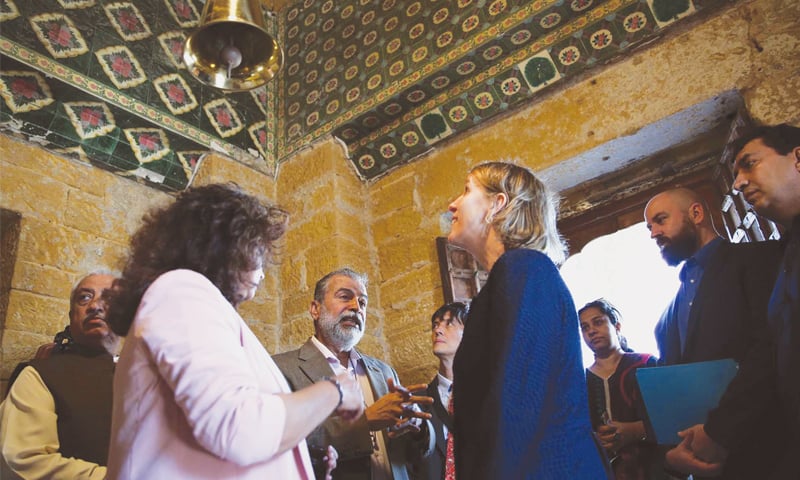KARACHI: Quaid-i-Azam Mohammad Ali Jinnah wanted to see a unified and tolerant Pakistan for people from all backgrounds and he rightly said that all citizens of the state were equal citizens, United States Consul General Grace Shelton said here on Thursday.
The words of the Quaid from the mouth of a US diplomat pleasantly surprised the audience at the restoration completion ceremony of Varun Dev Mandir at Manora.
“It is great to see a mosque, a church and the shrine of Hazrat Yousuf Shah nearby this place. It promotes interfaith harmony. The US government chose the temple in 2015 for preservation and after two years of hectic effort, it is rehabilitated,” she said.
“Pakistan and Sindh have several culturally rich sites and the US government is always ready to support noble causes,” she added.
Architect Zulfiqar Noor, who oversaw the rehabilitation work, told Dawn: “The record we have tells us that the temple dates back to 1886 but it would have been much older.
“Restoring, rehabilitating, preserving and conserving it was a major challenge for us but we tried our best. It was built with sandstones, which is a natural stone extracted from mountains, while lime-based mortar was used to bond them.
“We found no evidence of the use of Cheeroly which was used to bond material before the invention of cement.”
Talking about the entrance and indoor and outdoor features, he said: “The original entrance of the temple which was not facing the sea was tilting and could have fallen had we not intervened. We not only saved it but also provided another entrance from the side facing the sea.
“The compound has cemented tiles which are historic. The ceramic tiles placed inside the Varun Dev temple were Japanese donated to the mandir by Seth Kimatrai, Seth Navalrai, Seth Tejumal and Seth Vishindas in memory of their late father Seth Assomal Rochiram Khivani Punjabi on April 12, 1937.”
Pakistan Hindu Council president Hotchand Karmani, speaking to the audience, said the temple was deteriorating and was not fit for prayers two years ago but due to the hard work of the US government and the Sindh Exploration and Adventure Society (SEAS) it had turned into a beautiful place.
Dr Asma Ibrahim, general secretary of SEAS, said: “The temple is one of a kind in Pakistan. It had been closed since the Babri Masjid incident in 1992 and was in precarious condition.
“Rough weather being on the seafront brought more challenges for us but selfless dedication of society made it possible for us to complete its restoration and preservation with the help of US Ambassador’s fund for cultural preservation.
“Sikhs, Hindus and Christians took active part in its repair which is a bright example of interfaith harmony.
“We celebrated Holi and Diwali here last year and organised art programmes with schoolchildren.”
Dr Kaleemullah Lashari, while discussing initial difficulties, said: “The foremost issue before us at the time of deciding to conserve it was who were we doing it for? This issue was decided in the very beginning that this is not for a particular community but for everyone.
“While repairing it, we were careful about our responsibility towards future generation, society, environment and sentiments of communities.”
He further said: “We decided not to change the structure and did it only when we had no other option left.
“It has a pleasant and welcoming entrance and it is now our responsibility to make it welcoming for all. If generous people come forward, we don’t need money from any fund.”
The caretaker, Kishan, told Dawn: “For Varun Dev Mandir, the idol of Krishna will be imported from India.
“Two minarets, walls, well, tiles and doors of the mandir have been improved during the last two years.”
Published in Dawn, January 26th, 2018













































Dear visitor, the comments section is undergoing an overhaul and will return soon.